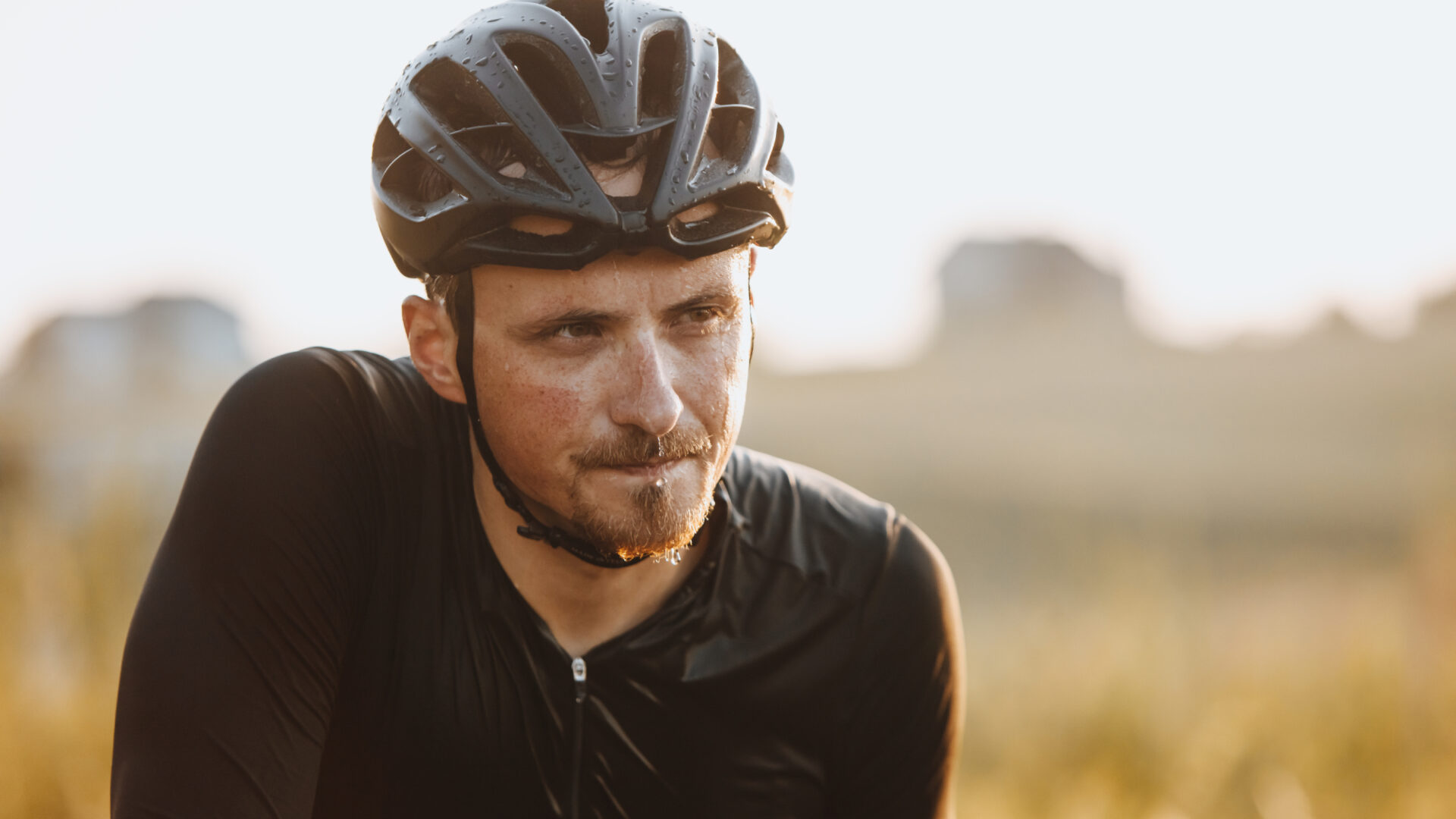Do your non-endurance friends or family members shake their heads at what you put yourself through, at the lengths you’re willing to take to get fitter and faster? The discomfort, the suffering, the sacrifices?
From the outside, endurance athletes seem to want to hurt themselves. Some, it’s fair to say, thrive during uncomfortable moments. They seek them out. Why? Why are so many of us driven to do this to ourselves?
Whether we realize it or not, there are immense psychological benefits to getting uncomfortable, whether that discomfort comes from physical stress or mental hardship. Motivation, self-awareness, and confidence are just a few of the attributes that can be improved through the use of discomfort as a tool for change and growth.
And then there’s resilience, one of the most studied and discussed psychological characteristics in recent years. Resilience blossoms as we overcome barriers and right ourselves. In that way, training for and competing in endurance sports is a crucible for creating more (or honing) resilience, a powerful tool in your athletic, professional, and personal arsenal.
“Resilience is the ability to return to functioning after any kind of setback, at least to where you were before and possibly beyond,” said sports psychologist Dr. Julie Emmerman.
If a big bike ride or a long trail run or a challenging triathlon can help shape us into more resilient, more confident, more motivated human beings, I’d say that’s worth the price of a little discomfort. It’s not unlike training our physiology.
“The dominant theory of physiology states that you need to produce a training stress to elicit an adaptation,” said endurance coach Grant Holicky. “The discomfort we’re seeking is effectively the psychological equivalent. You need to cause mental discomfort in order to grow. It’s the mental version of training stress.”
Are we programmed for discomfort?
There’s an evolutionary reason why discomfort is meant to be rare but rewarding.
“Humans evolved in a time of caloric scarcity,” Trevor Connor, coach and CEO of Fast Talk Labs, said. “Humans evolved to use energy only when absolutely necessary. The thing is, our brains use a lot of energy. To reduce the caloric demands of cognition, our brains evolved to quickly spot patterns and familiar situations, and to then process them or deal with the situation using very little power.”
To conserve energy, humans have two “levels” of brain usage: There’s the rudimentary and efficient kind, and then there’s the brain power that demands more uncomfortable thinking, the kind that involves overcoming a pattern that disagrees with what we might already believe.
This deep thought requires a lot of energy. So we are hardwired to use this more taxing brain power only when absolutely necessary.
“If what you are used to doing suddenly isn’t in line with survival, then you’re willing to do that higher-level thinking and change the way you think,” Connor said. “Unfortunately, we are programmed to instinctively avoid that.”
Here’s the catch: We do our best thinking during these times of discomfort; that’s when we grow. Deep thought inevitably leads to discomfort. We are programmed that way.
So, when we find something to be easy—be it a skill or an endurance challenge—we can be sure we’re only at that lower level of thought. We aren’t growing. Seek the uncomfortable—not all the time, but every so often—and you can be certain you are creating transformative potential.
To put it in simpler but no less meaningful terms, reaching places of discomfort with the goal of pushing through those experiences yields self-understanding, which creates opportunities to recalibrate our capabilities.
By pushing boundaries we soon realize they’re not actually boundaries—we’ve been constrained by arbitrary endpoints, which begs the question: What if they were merely starting points?
As you steadily extend where you’re able to go, and how you deal with adverse circumstances, you become comfortable being uncomfortable. Importantly, you begin seeking out opportunities for discomfort and change, knowing that they’ll lead to small but meaningful alterations. And that’s the very definition of transformation.
This type of discomfort-seeking behavior was the subject of a 2022 study published in Psychological Science. The authors asked: What if instead of tolerating discomfort (e.g., feeling awkward or uncomfortable), people actively sought it out? They reasoned that because discomfort is usually experienced immediately and is easy to detect, seeking discomfort as a signal of growth can increase motivation.
The researchers from Cornell University and the University of Chicago conducted five different experiments in which over 2,100 people engaged in personal growth activities. They found that people who aimed to be uncomfortable were more engaged in their activities, felt more motivated to keep doing them, and believed they made more progress toward their goals compared to those who weren’t seeking out this kind of vulnerability.
This particular study looked at social circumstances rather than athletic feats. Still, it’s reasonable to believe that the situation that brought about the discomfort was less important to eliciting positive change than the feelings of discomfort themselves.
Process makes progress
“It’s not about the goal, it’s about the journey.” You may have heard this mantra quoted by a sport psychologist or life coach. Have you ever stopped to fully consider what it means?
When a journey ends, many of the learning opportunities vanish. However, in the midst of challenges and uncomfortable situations, that’s when there is the opportunity to test ourselves, to evaluate strategies to cope, and to modify and change our demeanor, our reaction, and our approach—in the moment.
It’s important to note that there is ordinary discomfort—things like pre-race anxiety—that is routine, natural, and easy to work through. And then there’s transformative discomfort. These are the feelings you’d deal with as you lead into your first 100-plus-mile gravel race or a week-long bikepacking event—facing things you’ve never experienced before that are both physically and psychologically demanding. There might be problem-solving, route-finding, and mental hurdles you didn’t expect to face. Resilience will be a factor for success.
In any case, it’s something you choose to do, in part because you’re not even sure you can complete it. In the lead up you may be getting uncomfortable. Your inner dialogue might sound something like this: “Oh boy, what have I gotten myself into? Am I having a midlife crisis? Am I heading for a divorce?” If the answer is “oh shit” or “maybe” to any of those questions, you’re on the right track.
Joking aside, that’s when high-level thinking begins. You form a plan. You get organized. You devise a training regimen, an equipment list, a series of strategies to cope with the unknowns. Others will want to meditate and tell the world to be quiet. That’s okay too; everything will be fine. Whatever it is that you do, there is a process, a procedure, and a plan.
The next thing you know—through the act of chunking, or breaking a giant task into more digestible portions—you start to build confidence. You problem-solve. You turn fear into energy. You turn anxiety into anticipation. And you overcome obstacles. This can be generally defined as resilience.
Discomfort builds resiliency
As we’ve already learned, resilience is the ability to recover or improve after a setback. Consider the analogy of the broken bone, which is said to heal stronger after it breaks. Dr. Emmerman looks at resilience in a similar fashion. We build back stronger.
“There are extensive definitions of what it is and what it isn’t,” Emmerman said. “And rather than get into the tit for tat of how it is defined, I prefer to recognize that resilience is something that changes over time, and depends on somebody’s environment and the context.”
Resilience is much talked about, and for good reason. The characteristic is critical to athletic success. Resilient athletes view change as impermanent—that negative (or uncomfortable) moments will pass. Through the act of reframing, resilient athletes see all things as opportunities—even discomfort is a chance for growth.
In the end, the simple task of riding your bike or running trails can mature into a vehicle for development; a means to becoming a more humble, more skillful, more joyful human being.
The right dose of discomfort
Not all discomfort is built the same; therefore, not all discomfort is beneficial. We must be careful to differentiate discomfort from true pain before we can determine how discomfort leads to transformation.
Discomfort, by definition, is the experience of something feeling uneasy. Sometimes it is simply something that is unfamiliar. It is considered a slight or mild “pain.” True pain, however, will be interpreted as a signal that something is wrong, abnormal, and will be felt more pointedly. The sensation will likely be pronounced, and could be defined as suffering, distress, injury, or illness.
Feelings of discomfort are usually inherent in unfamiliar circumstances. Pain, however, is your nervous system’s way of expressing that something is wrong, in an attempt to protect itself from further injury. Pain is often localized and felt intensely, depending on the source. Discomfort can feel like a general challenge—think burning in the muscles, fatigue, or heaviness.
So, how does discomfort lead to growth while pain leads to injury, misery, or both?
To reap the rewards of being uncomfortable (and to make it something we’re comfortable with) takes practice. One of the most effective ways to improve our relationship with beneficial discomfort is to understand why we choose to partake in endurance sports.
This is our motivation. There are internal motivators (intrinsic) and external motivators (extrinsic). Using intrinsic motivation yields feelings of purpose, intention, and focus—we are enthusiastic about the changes we are gaining from the work that we’re doing. Discomfort becomes an afterthought—or better yet, a means to an end.
This leads to a willingness to venture into uncomfortable places, because we know that during those times we have the best opportunities for transformation.
Again, this is backed by the research. Part of the successful strategy for benefiting from discomfort involves reframing those feelings as something positive. The aforementioned researchers found that people who embrace some level of discomfort do better even during the biggest challenges. They are more likely to take creative risks that can aid in problem-solving and find meaning in difficulty, according to the study. Those who learned to embrace discomfort also felt a greater sense of achievement when the experience was over.
If you treat yourself and your endurance sport of choice with the respect they deserve; if you listen to your inner dialogue to differentiate between discomfort and pain; if you manage your emotions and seek opportunities to learn, progress, and transform during challenging moments; then rest assured that you are becoming a stronger, wiser version of yourself, simply by doing what you love to do.
Your friends should be jealous.
References
Woolley, K., & Fishbach, A. (2022). Motivating Personal Growth by Seeking Discomfort. Psychological Science, 33(4), 510–523. https://doi.org/10.1177/09567976211044685
Crum A. J., Salovey P., Achor S. (2013). Rethinking stress: The role of mindsets in determining the stress response. Journal of Personality and Social Psychology, 104(4), 716–733. https://doi.org/10.1037/a0031201
Tamir M., Halperin E., Porat R., Bigman Y. E., Hasson Y. (2019). When there’s a will, there’s a way: Disentangling the effects of goals and means in emotion regulation. Journal of Personality and Social Psychology, 116(5), 795–816. https://doi.org/10.1037/pspp0000232
Brooks A. W. (2014). Get excited: Reappraising pre-performance anxiety as excitement. Journal of Experimental Psychology: General, 143(3), 1144–1158. https://doi.org/10.1037/a0035325




